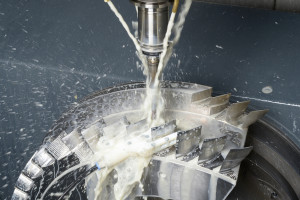 A new clamping system from the Fraunhofer Institute boosts vibration absorption for the blades of aircrafts turbines by more than 400 times, and cuts manufacturing costs by as much as 5000 euros.
A new clamping system from the Fraunhofer Institute boosts vibration absorption for the blades of aircrafts turbines by more than 400 times, and cuts manufacturing costs by as much as 5000 euros.
The clamping system promises a remedy for eliminating blade vibration. “With the clamping system, absorption in titanium blisks is 12.5 percent. Without it, absorption falls to just 0.027 percent,” says Roman Kalocsay, an engineer at IPT. Using the clamping system, manufacturers can roughly mill the blades first, and then perform the precise finishing work because the blades no longer vibrate.
So how does the clamping system work? “Spring-loaded clamps automatically grasp the blade with equal amounts of tension on both sides,” Kalocsay explains. “As soon as the elements are in position, they are hydraulically clamped in place and hold the workpiece as if it had grown there.” The clamping system prototype was created by the Fraunhofer Innovation Cluster Adaptive Production for Resource Efficiency in Energy Generation and Mobility AdaM.
During repair, the blades cannot be milled piece by piece out of the material – after all, all of the blades are already in place. Instead, if their edges appear to be “frayed”, for example, the manufacturer reapplies the material using laser metal deposition and then mills it to the desired form. Workers attempt to hold the blade in place as best they can using clamps or rubber, but it is nearly impossible to align them perfectly. Consequently, the workpieces must be re-measured afterwards in a time-consuming process because it is not clear how much they have drifted to the left or right. The clamping system helps here, too. “It doesn’t change the blisk’s geometry by even a micrometer. The blade is fixed in place in just a few seconds and can be worked on immediately,” says Kalocsay. The process is slightly different than with a new blisk, however: The clamping elements are arranged in a circle and hold, not one, but all blades at the same time.



